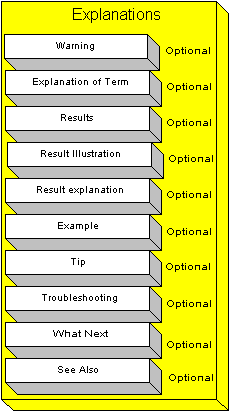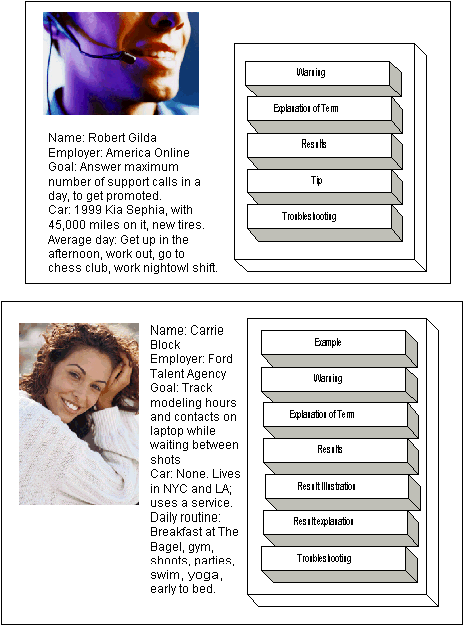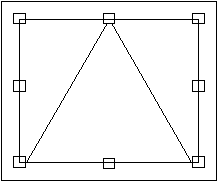|
Why put different types of explanations in separate paragraphs?
Carving explanations up into separate paragraphs, each addressing a
specific type of question, makes the explanations into distinct elements,
so you and your users can reuse, include, or exclude them on the fly.
Planning several distinct explanation types speeds up writing, too,
because you are not trying to weave several different kinds of information
together into a compelling paragraph.
You are just sorting facts into bins--and in the process, your prose gets
simpler, more purposeful, and, because you are just answering one question
per paragraph, abrupt.
Yes, some of these paragraphs end up being one sentence, or a single
phrase. If that sentence
or phrase answers the question, hey, that's all you need.
Follow the user's thought
process
Your visitors have their own questions,
which tend to arise in a certain, fairly predictable order. You
could think of these appearing from moment to moment, as the mind ponders
the instruction, follows it, and tries to decide whether or not the action
was a success.
Try to figure out what those questions
are, and in what order they normally appear. You'll often find that there is
a natural order to the questions that occur to most users after they read
your step.
Keep to a standard
organization in these follow-up paragraphs, answering each virtual
question as it naturally appears.
For example, here is the sequence of questions we've found users ask,
sotto voce, as they make their way through procedures for using software.
Imagine they have just read a step. Now their mind starts worrying.
Here are the questions, with suggestions on how to respond.
1. What should I watch out for?
(Put any warnings right after an instruction that could lead users into
danger.)
2. What do those strange terms mean?
(Explain any obscure terms in the instruction. Give any supplementary
details that will help the user carry out the instruction. "The icon
appears in the lower right corner of your screen.")
3. What's the result of doing this?
(Describe the results of carrying out the step. Discuss the results
whenever customers are faced with something new, unusual, unexpected, or
subtle and hard to notice. Include "how it works" ONLY if user must infer
what is going on inside the machine.)
4. Does my result look like yours?
(Display screen shots to show the results, even if you need to repeat
pictures. Sometimes you need art to show the result of one action, and
then the location of the next step's action.)
5. What do these results mean?
(Explain the results in depth, if necessary.)
6. Could you give me an example of the way this works?
(Give an example. If you think one would help, build the example in three
parts: a description of the situation and the purpose of the person in
your story, the action that person took, and the result.)
7. Any tips for getting through this maze?
(Offer tips only when they are real extra ideas, not secret warnings, or
background.)
8. I'm in trouble: how do I get out?
(Offer troubleshooting advice right when the trouble could happen.)
9. What do I do next?
(When the reasoning behind the sequence is not obvious, suggest why
customers should take the next step. The explanation should help motivate
customers to continue.)
10. Where can I go for more information?
(Add see-also cross references, if they would really be helpful.)

In most circumstances, you would use only one or two of these elements.
But you need to have a whole set of explanation types ready to go, with a
clear idea of the ideal sequence, so that when you realize users may be
confused, you can jump in.
Of course, many writers believe that their instructions are so clear that
no one could go wrong. These are all writers who have decided that
they do not need to test their instructions on real people. Once you test,
you realize how many ways people get get lost after reading a step that
you think is supremely simple.
Personalizing the pattern
Individuals have different tastes in
explanations. Some like everything you can give them; others prefer
a Spartan procedure, with just a few critical explanations. Here are
two personalized patterns:

Example of revising explanations
Before
Now that you have selected the figure, you can move it. See also: How to
Mouse Around. Note: Don't touch the handles, or else you might change the
size or shape of the figure. When clicking, you should be careful not to
click a nearby figure, or the background, because that way you might be
selecting some other object. Note: clicking is putting the tip of the
pointer on a line in the figure and pressing the left mouse button.
After
Be careful not to click the object next to the figure, or the
white space around the figure, because you would then be selecting the
other object, or, possibly, the rectangle that lies in the background.
To click, place the tip of the pointer on one of the lines of the figure,
then press the left mouse button.
When you've clicked the figure, you see little squares appear at the
corners of your figure, and in a rectangle around the figure; these
squares are called handles.

The handles allow you to resize or reshape your figure. (Don't touch them
right now).
Now that you have selected the figure, you can move it.
See also: How to Mouse Around.
|




